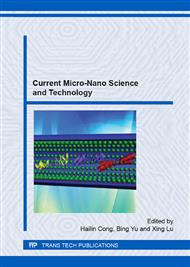[1]
S. L. Gurmeet, K. Sanjeev, N. K. Verma, Fabrication and electrical characterization of highly ordered copper nanowires, Appl. Nanosci. 2 (2012) 7-13.
Google Scholar
[2]
M. S. Sander, R. Gronsky, T. Sands, and A. M. Sracy, Structure of Bismuth Telluride nanowire arrays fabricated by electrodeposition into porous anodic alumina templates, J. Chem. Mater. 15 (2003) 335-339.
DOI: 10.1021/cm0207604
Google Scholar
[3]
Y. Xia, P. Yang, Y. Sun, Y. Wu, B. Mayers , B. Gates , Y. Yin, F. Kim, and H. Yan, One-dimensional nanostructures: synthesis, characterization, and applications, Adv. Mater. 15 (2003) 353-389.
DOI: 10.1002/adma.200390087
Google Scholar
[4]
M. S. Gudiksen, L. J. Lauhon, J. Wang, D. C. Smith, and C. Lieber, Growth of nanowire superlattice structures for nanoscale photonics and electronics, Nature 415 (2002) 617-620.
DOI: 10.1038/415617a
Google Scholar
[5]
U. Kriebig, M. Vollmer, Springer-Verlag, Optical properties of metal clusters, Heidelberg, Germany, (1995).
Google Scholar
[6]
Z. Q. Tian, B. Ren, D. Y. Wu, Surface-enhanced Raman scattering: from noble to transition metals and from rough surfaces to ordered nanostructures, J. Phys. Chem. B 106 (2002).
DOI: 10.1021/jp0257449
Google Scholar
[7]
D. P. E. Smith, Quantum point contact switches, Science 269 (1995) 371-373.
Google Scholar
[8]
R. L. Zong, J. Zhou, Q. Li, B. Du, B. Li, M. Fu, X. W. Qi, and L. T. Li, Synthesis and optical properties of silver nanowire arrays embedded in anodic alumina membrane, J. Phys. Chem. B 108 (2004) 16713-16716.
DOI: 10.1021/jp0474172
Google Scholar
[9]
Y. Y. Zhang, W. Xu, S. H. Xu, T. F. Guo, Y. M. Xiao, and J. G. Hu, Optical properties of Ni and Cu nanowire arrays and Ni/Cu superlattice nanowire arrays, Nano. Lett. 7 (2012) 569.
DOI: 10.1186/1556-276x-7-569
Google Scholar
[10]
L. W. Chou, N. Shin, S. V. Sivaram, M. A. Filler, Tunable mid-infrared localized surface plasmon resonances in silicon nanowires, J. Am. Chem. Soc. 134 (2012) 16155-16158.
DOI: 10.1021/ja3075902
Google Scholar
[11]
W. F. Zhou, T. F. Guo, X. F. Li, S. H. Xu, L. Chen, B. Wu, and L. D. Zhang, In situ X-ray diffraction study on the orientation-dependent thermal expansion of Cu nanowires, J. Phys. Chem. C 113 (2009) 9568-9572.
DOI: 10.1021/jp900047q
Google Scholar


